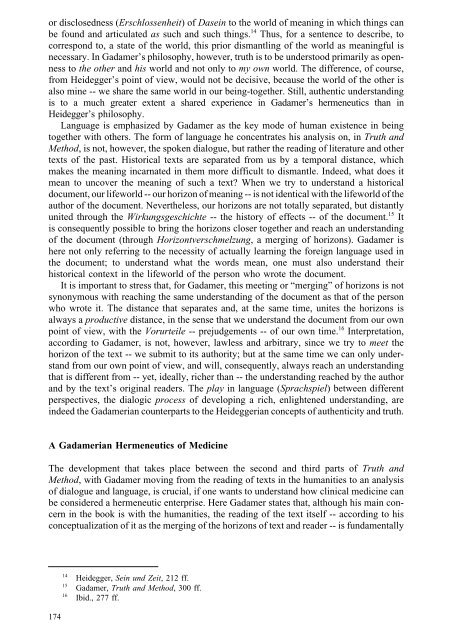[Andrzej_Wiercinski_(ed ... - WordPress.com
[Andrzej_Wiercinski_(ed ... - WordPress.com
[Andrzej_Wiercinski_(ed ... - WordPress.com
Create successful ePaper yourself
Turn your PDF publications into a flip-book with our unique Google optimized e-Paper software.
or disclos<strong>ed</strong>ness (Erschlossenheit) of Dasein to the world of meaning in which things canbe found and articulat<strong>ed</strong> as such and such things. 14 Thus, for a sentence to describe, tocorrespond to, a state of the world, this prior dismantling of the world as meaningful isnecessary. In Gadamer’s philosophy, however, truth is to be understood primarily as opennessto the other and his world and not only to my own world. The difference, of course,from Heidegger’s point of view, would not be decisive, because the world of the other isalso mine -- we share the same world in our being-together. Still, authentic understandingis to a much greater extent a shar<strong>ed</strong> experience in Gadamer’s hermeneutics than inHeidegger’s philosophy.Language is emphasiz<strong>ed</strong> by Gadamer as the key mode of human existence in beingtogether with others. The form of language he concentrates his analysis on, in Truth andMethod, is not, however, the spoken dialogue, but rather the reading of literature and othertexts of the past. Historical texts are separat<strong>ed</strong> from us by a temporal distance, whichmakes the meaning incarnat<strong>ed</strong> in them more difficult to dismantle. Inde<strong>ed</strong>, what does itmean to uncover the meaning of such a text? When we try to understand a historicaldocument, our lifeworld -- our horizon of meaning -- is not identical with the lifeworld of theauthor of the document. Nevertheless, our horizons are not totally separat<strong>ed</strong>, but distantlyunit<strong>ed</strong> through the Wirkungsgeschichte -- the history of effects -- of the document. 15 Itis consequently possible to bring the horizons closer together and reach an understandingof the document (through Horizontverschmelzung, a merging of horizons). Gadamer ishere not only referring to the necessity of actually learning the foreign language us<strong>ed</strong> inthe document; to understand what the words mean, one must also understand theirhistorical context in the lifeworld of the person who wrote the document.It is important to stress that, for Gadamer, this meeting or “merging” of horizons is notsynonymous with reaching the same understanding of the document as that of the personwho wrote it. The distance that separates and, at the same time, unites the horizons isalways a productive distance, in the sense that we understand the document from our ownpoint of view, with the Vorurteile -- prejudgements -- of our own time. 16 Interpretation,according to Gadamer, is not, however, lawless and arbitrary, since we try to meet thehorizon of the text -- we submit to its authority; but at the same time we can only understandfrom our own point of view, and will, consequently, always reach an understandingthat is different from -- yet, ideally, richer than -- the understanding reach<strong>ed</strong> by the authorand by the text’s original readers. The play in language (Sprachspiel) between differentperspectives, the dialogic process of developing a rich, enlighten<strong>ed</strong> understanding, areinde<strong>ed</strong> the Gadamerian counterparts to the Heideggerian concepts of authenticity and truth.A Gadamerian Hermeneutics of M<strong>ed</strong>icineThe development that takes place between the second and third parts of Truth andMethod, with Gadamer moving from the reading of texts in the humanities to an analysisof dialogue and language, is crucial, if one wants to understand how clinical m<strong>ed</strong>icine canbe consider<strong>ed</strong> a hermeneutic enterprise. Here Gadamer states that, although his main concernin the book is with the humanities, the reading of the text itself -- according to hisconceptualization of it as the merging of the horizons of text and reader -- is fundamentally141516Heidegger, Sein und Zeit, 212 ff.Gadamer, Truth and Method, 300 ff.Ibid., 277 ff.174


